Crustal Imaging across the Princess Elizabeth Land, East Antarctica from 2D Gravity and Magnetic Inversions
Abstract
:1. Introduction
2. Geophysical Data Setting
2.1. Field Data Collection
2.2. Geophysical Inversion
3. Geophysical and Geological Interpretation
4. Discussion
4.1. Transilience of Physical Properties in Deep Bedrock
4.2. Indo-Antarctic
4.3. Tectonic Model
4.4. Uncertainty Analysis
5. Conclusions
Author Contributions
Funding
Data Availability Statement
Acknowledgments
Conflicts of Interest
References
- Fretwell, P.; Pritchard, H.D.; Vaughan, D.G.; Bamber, J.L.; Barrand, N.E.; Bell, R.; Bianchi, C.; Bingham, R.; Blankenship, D.D.; Casassa, G.; et al. Bedmap2: Improved ice bed, surface and thickness datasets for Antarctica. Cryosphere 2013, 7, 375–393. [Google Scholar] [CrossRef]
- Maritati, A.; Danišík, M.; Halpin, J.A.; Whittaker, J.M.; Aitken, A.R. Pangea rifting shaped the East Antarctic landscape. Tectonics 2020, 39, e2020TC006180. [Google Scholar] [CrossRef]
- Hoffman, P.F. Did the breakout of Laurentia turn Gondwanaland inside-out? Science 1991, 252, 1409–1412. [Google Scholar] [CrossRef]
- Meert, J.G. Paleomagnetic evidence for a Paleo-Mesoproterozoic supercontinent Columbia. Gondwana Res. 2002, 5, 207–215. [Google Scholar] [CrossRef]
- Rogers, J.J.; Santosh, M. Configuration of Columbia, a Mesoproterozoic supercontinent. Gondwana Res. 2002, 5, 5–22. [Google Scholar] [CrossRef]
- Li, Z.X.; Bogdanova, S.; Collins, A.; Davidson, A.; De Waele, B.; Ernst, R.; Fitzsimons, I.; Fuck, R.; Gladkochub, D.; Jacobs, J.; et al. Assembly, configuration, and break-up history of Rodinia: A synthesis. Precambrian Res. 2008, 160, 179–210. [Google Scholar] [CrossRef]
- Meert, J.G. What’s in a name? The Columbia (Paleopangaea/Nuna) supercontinent. Gondwana Res. 2012, 21, 987–993. [Google Scholar] [CrossRef]
- Nance, R.D.; Murphy, J.B.; Santosh, M. The supercontinent cycle: A retrospective essay. Gondwana Res. 2014, 25, 4–29. [Google Scholar] [CrossRef]
- Aitken, A.; Roberts, J.; Van Ommen, T.; Young, D.; Golledge, N.; Greenbaum, J.; Blankenship, D.; Siegert, M. Repeated large-scale retreat and advance of Totten Glacier indicated by inland bed erosion. Nature 2016, 533, 385–389. [Google Scholar] [CrossRef]
- Boger, S.D. Antarctica—Before and after Gondwana. Gondwana Res. 2011, 19, 335–371. [Google Scholar] [CrossRef]
- Aitken, A.; Betts, P.; Young, D.; Blankenship, D.D.; Roberts, J.; Siegert, M.J. The Australo-Antarctic Columbia to Gondwana transition. Gondwana Res. 2016, 29, 136–152. [Google Scholar] [CrossRef]
- Xiao, E.; Jiang, F.; Guo, J.; Latif, K.; Fu, L.; Sun, B. 3D Interpretation of a Broadband Magnetotelluric Data Set Collected in the South of the Chinese Zhongshan Station at Prydz Bay, East Antarctica. Remote Sens. 2022, 14, 496. [Google Scholar] [CrossRef]
- Ferraccioli, F.; Armadillo, E.; Jordan, T.; Bozzo, E.; Corr, H. Aeromagnetic exploration over the East Antarctic Ice Sheet: A new view of the Wilkes Subglacial Basin. Tectonophysics 2009, 478, 62–77. [Google Scholar] [CrossRef]
- Holmes, R.C.; Tolstoy, M.; Harding, A.J.; Orcutt, J.A.; Morgan, J.P. Australian Antarctic Discordance as a simple mantle boundary. Geophys. Res. Lett. 2010, 37, L09309. [Google Scholar] [CrossRef]
- Aitken, A.R.A.; Young, D.; Ferraccioli, F.; Betts, P.G.; Greenbaum, J.S.; Richter, T.G.; Roberts, J.L.; Blankenship, D.D.; Siegert, M.J. The subglacial geology of Wilkes land, East Antarctica. Geophys. Res. Lett. 2014, 41, 2390–2400. [Google Scholar] [CrossRef]
- Daczko, N.R.; Halpin, J.A.; Fitzsimons, I.C.; Whittaker, J.M. A cryptic Gondwana-forming orogen located in Antarctica. Sci. Rep. 2018, 8, 8371. [Google Scholar] [CrossRef] [PubMed]
- Ebbing, J.; Dilixiati, Y.; Haas, P.; Ferraccioli, F.; Scheiber-Enslin, S. East Antarctica magnetically linked to its ancient neighbours in Gondwana. Sci. Rep. 2021, 11, 5513. [Google Scholar] [CrossRef]
- Liu, X.; Zhao, Y.; Hu, J. The c. 1000–900 Ma and c. 550–500 Ma tectonothermal events in the Prince Charles Mountains–Prydz Bay region, East Antarctica, and their relations to supercontinent evolution. Geol. Soc. Lond. Spec. Publ. 2013, 383, 95–112. [Google Scholar] [CrossRef]
- Liu, X.; Wang, W.; Zhao, Y.; Liu, J.; Chen, H.; Cui, Y.; Song, B. Early Mesoproterozoic arc magmatism followed by early Neoproterozoic granulite facies metamorphism with a near-isobaric cooling path at Mount Brown, Princess Elizabeth Land, East Antarctica. Precambrian Res. 2016, 284, 30–48. [Google Scholar] [CrossRef]
- Arora, D.; Pant, N.; Pandey, M.; Chattopadhyay, A.; Greenbaum, J.; Siegert, M.; Bo, S.; Blankenship, D.; Rao, N.C.; Bhandari, A. Insights into geological evolution of Princess Elizabeth Land, East Antarctica-clues for continental suturing and breakup since Rodinian time. Gondwana Res. 2020, 84, 260–283. [Google Scholar] [CrossRef]
- Mikhalsky, E.; Belyatsky, B.; Presnyakov, S.; Skublov, S.; Kovach, V.; Rodionov, N.; Antonov, A.; Saltykova, A.; Sergeev, S. The geological composition of the hidden Wilhelm II Land in East Antarctica: SHRIMP zircon, Nd isotopic and geochemical studies with implications for Proterozoic supercontinent reconstructions. Precambrian Res. 2015, 258, 171–185. [Google Scholar] [CrossRef]
- Sadiq, M.; Dharwadkar, A.; Roy, S.K.; Arora, D.; Shah, M.Y.; Bhandari, A. Thermal evolution of mafic granulites of Princess Elizabeth Land, East Antarctica. Polar Sci. 2021, 30, 100641. [Google Scholar] [CrossRef]
- Harley, S. Archaean-Cambrian crustal development of East Antarctica: Metamorphic characteristics and tectonic implications. Geol. Soc. Lond. Spec. Publ. 2003, 206, 203–230. [Google Scholar] [CrossRef]
- Gambetta, M.; Armadillo, E.; Carmisciano, C.; Stefanelli, P.; Cocchi, L.; Tontini, F.C. Determining geophysical properties of a near-surface cave through integrated microgravity vertical gradient and electrical resistivity tomography measurements. J. Cave Karst Stud. 2011, 73, 11–15. [Google Scholar] [CrossRef]
- Wei, X.; Sun, J. Uncertainty analysis of 3D potential-field deterministic inversion using mixed Lp norms. Geophysics 2021, 86, G133–G158. [Google Scholar] [CrossRef]
- Mehanee, S.A. A New Scheme for Gravity Data Interpretation by a Faulted 2-D Horizontal Thin Block: Theory, Numerical Examples, and Real Data Investigation. IEEE Trans. Geosci. Remote. Sens. 2022, 60, 4705514. [Google Scholar] [CrossRef]
- Cui, X.; Jeofry, H.; Greenbaum, J.; Guo, J.; Li, L.; Lindzey, L.; Habbal, F.; Wei, W.; Young, D.; Ross, N.; et al. Bed topography of Princess Elizabeth Land in East Antarctica. Earth Syst. Sci. Data 2020, 12, 2765–2774. [Google Scholar] [CrossRef]
- Li, Y.; Oldenburg, D.W. 3-D inversion of magnetic data. Geophysics 1996, 61, 394–408. [Google Scholar] [CrossRef]
- Li, Y.; Oldenburg, D.W. 3-D inversion of gravity data. Geophysics 1998, 63, 109–119. [Google Scholar] [CrossRef]
- Mehanee, S.; Golubev, N.; Zhdanov, M.S. Weighted regularized inversion of magnetotelluric data. In SEG Technical Program Expanded Abstracts 1998; Society of Exploration Geophysicists: Houston, TX, USA, 1998; pp. 481–484. [Google Scholar]
- Zhdanov, M.S. Geophysical Inverse Theory and Regularization Problems; Elsevier: Amsterdam, The Netherlands, 2002; Volume 36. [Google Scholar]
- Fournier, D.; Oldenburg, D.W. Inversion using spatially variable mixed lp norms. Geophys. J. Int. 2019, 218, 268–282. [Google Scholar] [CrossRef]
- Wei, X.; Sun, J. 3D probabilistic geology differentiation based on airborne geophysics, mixed L p norm joint inversion, and physical property measurements. Geophysics 2022, 87, K19–K33. [Google Scholar] [CrossRef]
- Cockett, R.; Kang, S.; Heagy, L.J.; Pidlisecky, A.; Oldenburg, D.W. SimPEG: An open source framework for simulation and gradient based parameter estimation in geophysical applications. Comput. Geosci. 2015, 85, 142–154. [Google Scholar] [CrossRef]
- Heagy, L.J.; Cockett, R.; Kang, S.; Rosenkjaer, G.K.; Oldenburg, D.W. A framework for simulation and inversion in electromagnetics. Comput. Geosci. 2017, 107, 1–19. [Google Scholar] [CrossRef]
- Golynsky, A.V.; Ferraccioli, F.; Hong, J.K.; Golynsky, D.A.; von Frese, R.R.B.; Young, D.A.; Blankenship, D.D.; Holt, J.W.; Ivanov, S.V.; Kiselev, A.V.; et al. New magnetic anomaly map of the Antarctic. Geophys. Res. Lett. 2018, 45, 6437–6449. [Google Scholar] [CrossRef]
- Maritati, A.; Aitken, A.; Young, D.; Roberts, J.; Blankenship, D.; Siegert, M. The tectonic development and erosion of the Knox subglacial sedimentary basin, East Antarctica. Geophys. Res. Lett. 2016, 43, 10–728. [Google Scholar] [CrossRef]
- Fitzsimons, I. Grenville-age basement provinces in East Antarctica: Evidence for three separate collisional orogens. Geology 2000, 28, 879–882. [Google Scholar] [CrossRef]
- Halpin, J.A.; Daczko, N.R.; Kobler, M.E.; Whittaker, J.M. Strike-slip tectonics during the Neoproterozoic–Cambrian assembly of East Gondwana: Evidence from a newly discovered microcontinent in the Indian Ocean (Batavia Knoll). Gondwana Res. 2017, 51, 137–148. [Google Scholar] [CrossRef]
- Green, P.J. Reversible jump Markov chain Monte Carlo computation and Bayesian model determination. Biometrika 1995, 82, 711–732. [Google Scholar] [CrossRef]
- Agostinetti, N.P.; Malinverno, A. Receiver function inversion by trans-dimensional Monte Carlo sampling. Geophys. J. Int. 2010, 181, 858–872. [Google Scholar] [CrossRef]
- Blatter, D.; Key, K.; Ray, A.; Foley, N.; Tulaczyk, S.; Auken, E. Trans-dimensional Bayesian inversion of airborne transient EM data from Taylor Glacier, Antarctica. Geophys. J. Int. 2018, 214, 1919–1936. [Google Scholar] [CrossRef]
- Zhang, X.; Curtis, A.; Galetti, E.; De Ridder, S. 3-D Monte Carlo surface wave tomography. Geophys. J. Int. 2018, 215, 1644–1658. [Google Scholar] [CrossRef]

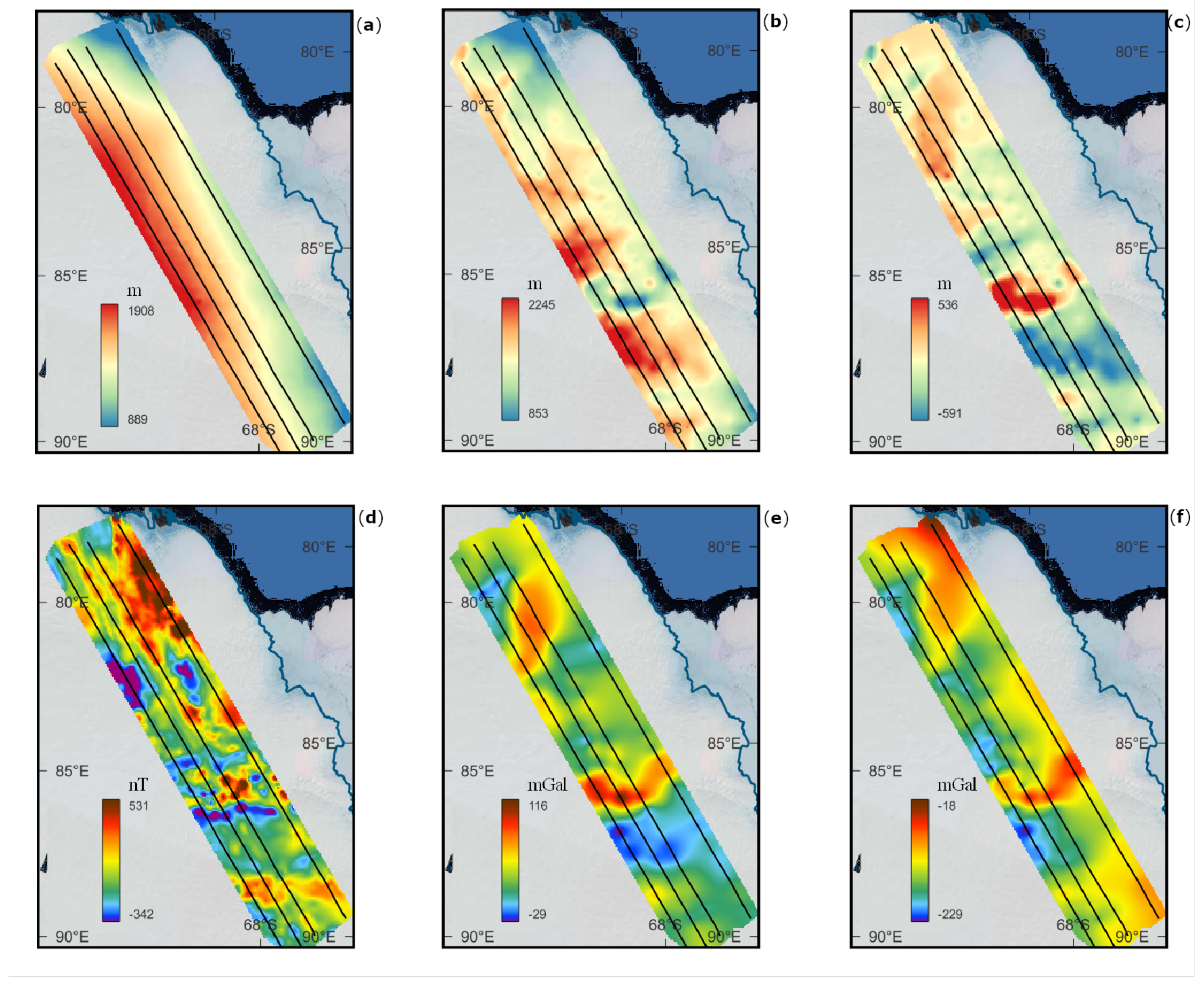

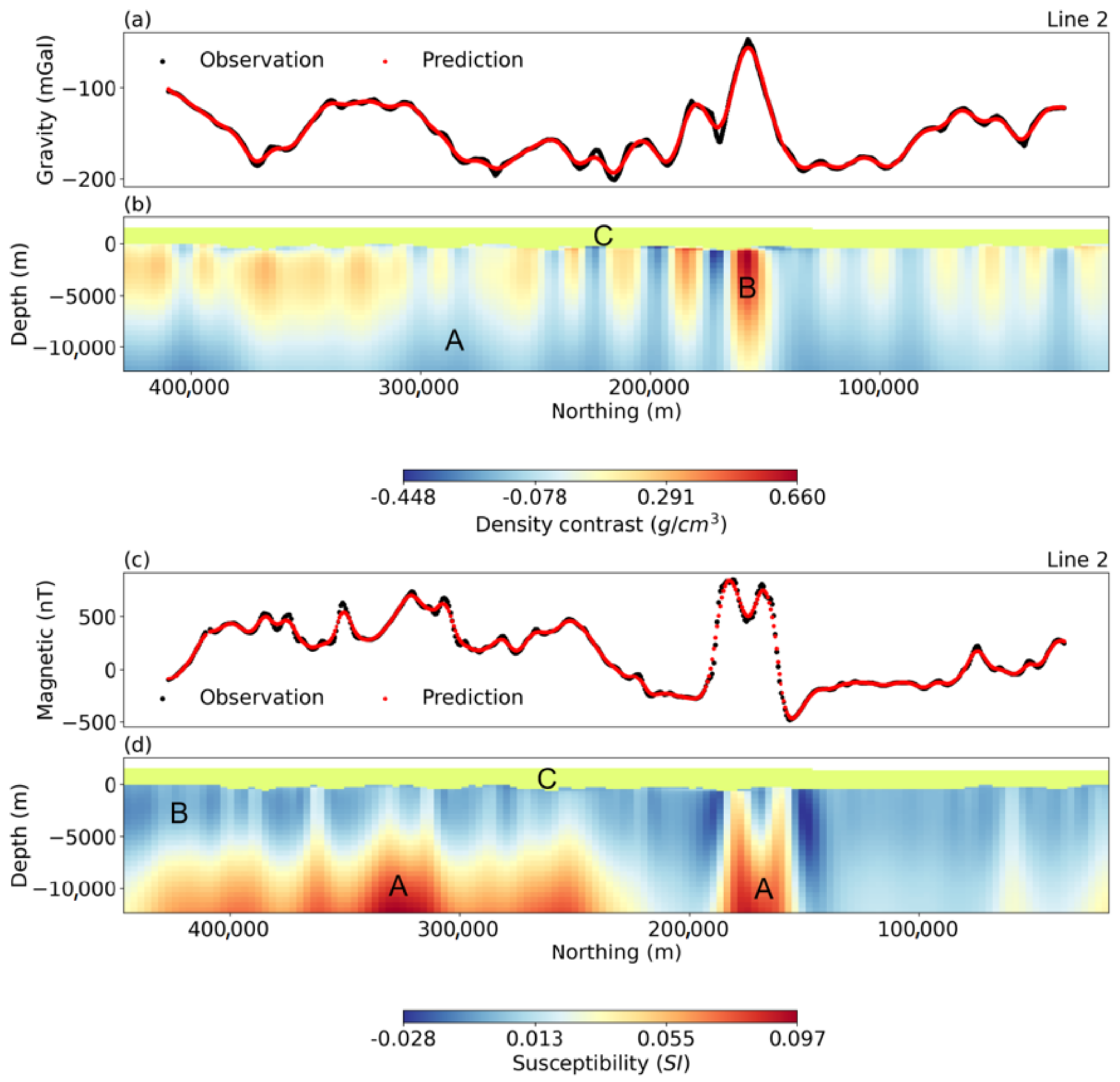
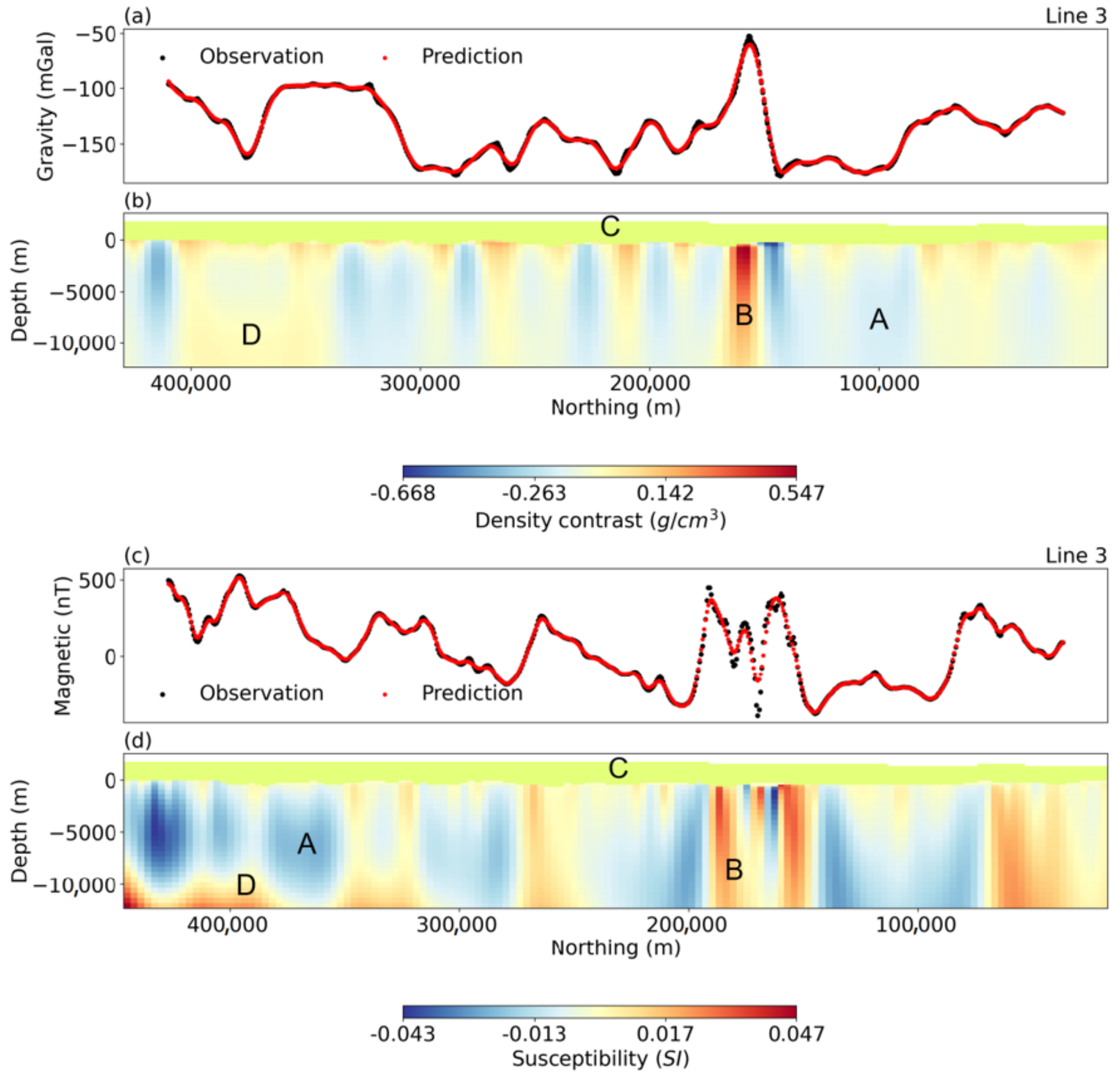
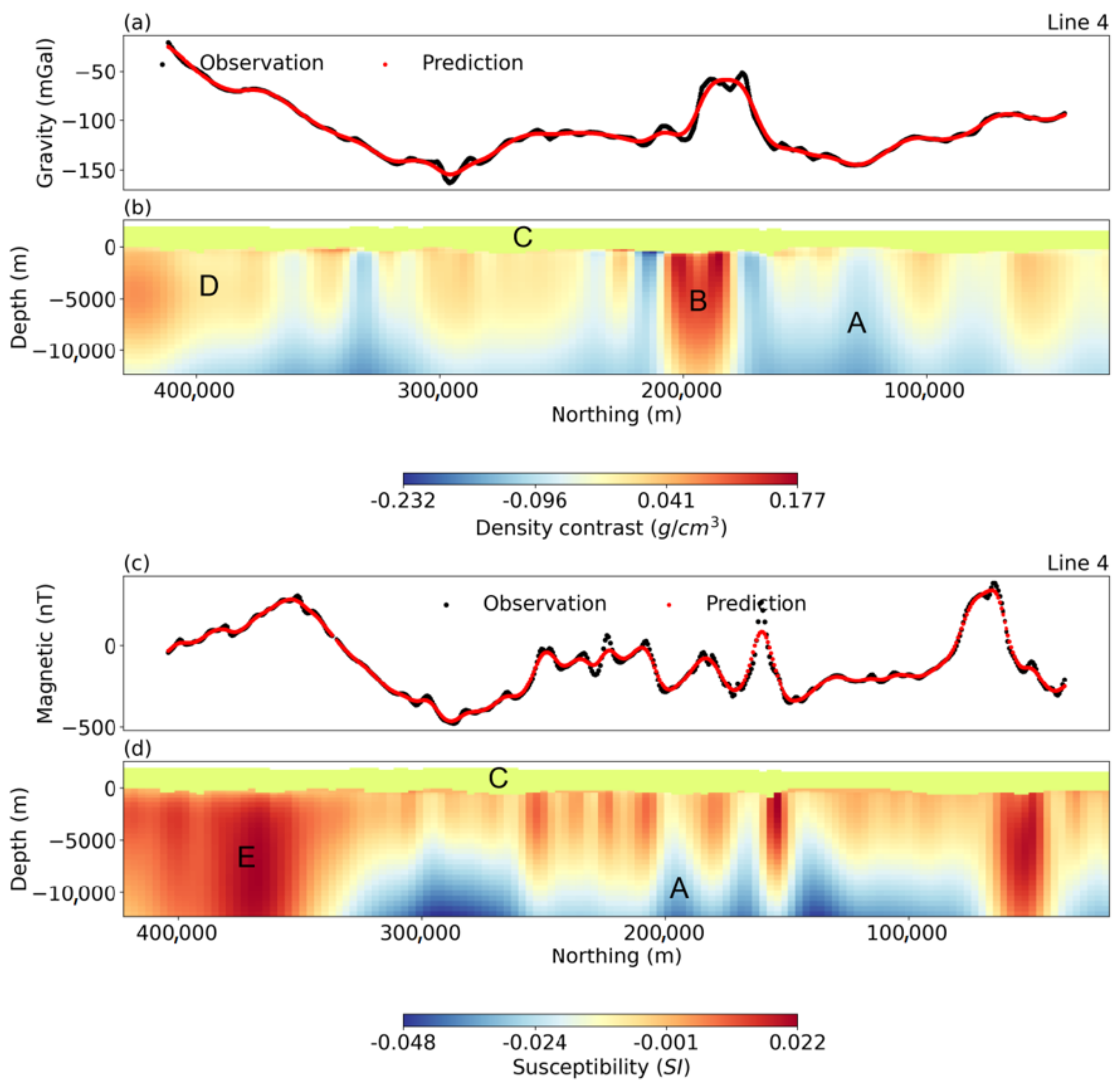
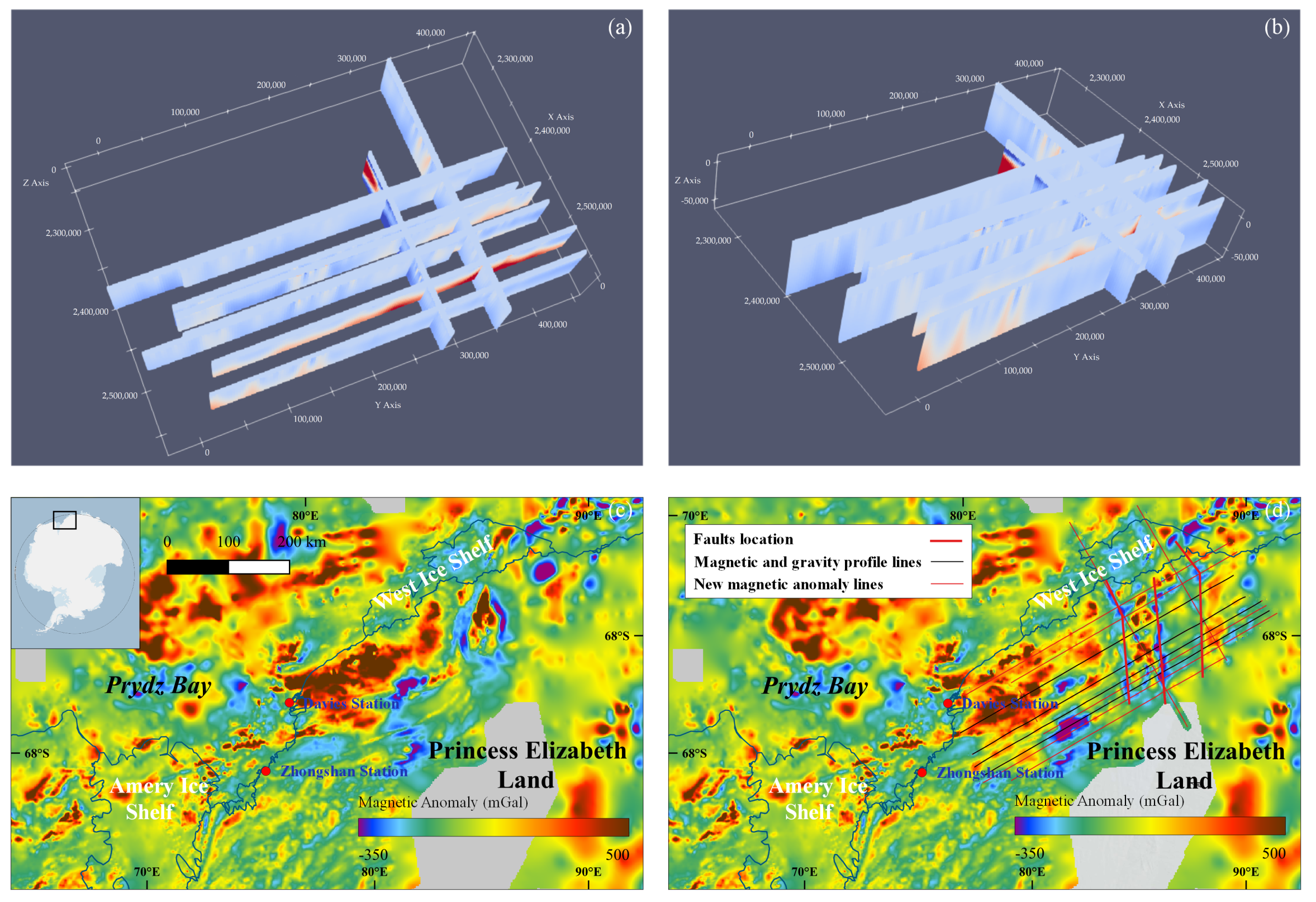

Disclaimer/Publisher’s Note: The statements, opinions and data contained in all publications are solely those of the individual author(s) and contributor(s) and not of MDPI and/or the editor(s). MDPI and/or the editor(s) disclaim responsibility for any injury to people or property resulting from any ideas, methods, instructions or products referred to in the content. |
© 2023 by the authors. Licensee MDPI, Basel, Switzerland. This article is an open access article distributed under the terms and conditions of the Creative Commons Attribution (CC BY) license (https://creativecommons.org/licenses/by/4.0/).
Share and Cite
Li, L.; Xiao, E.; Wei, X.; Qiu, N.; Latif, K.; Guo, J.; Sun, B. Crustal Imaging across the Princess Elizabeth Land, East Antarctica from 2D Gravity and Magnetic Inversions. Remote Sens. 2023, 15, 5523. https://doi.org/10.3390/rs15235523
Li L, Xiao E, Wei X, Qiu N, Latif K, Guo J, Sun B. Crustal Imaging across the Princess Elizabeth Land, East Antarctica from 2D Gravity and Magnetic Inversions. Remote Sensing. 2023; 15(23):5523. https://doi.org/10.3390/rs15235523
Chicago/Turabian StyleLi, Lin, Enzhao Xiao, Xiaolong Wei, Ning Qiu, Khalid Latif, Jingxue Guo, and Bo Sun. 2023. "Crustal Imaging across the Princess Elizabeth Land, East Antarctica from 2D Gravity and Magnetic Inversions" Remote Sensing 15, no. 23: 5523. https://doi.org/10.3390/rs15235523





